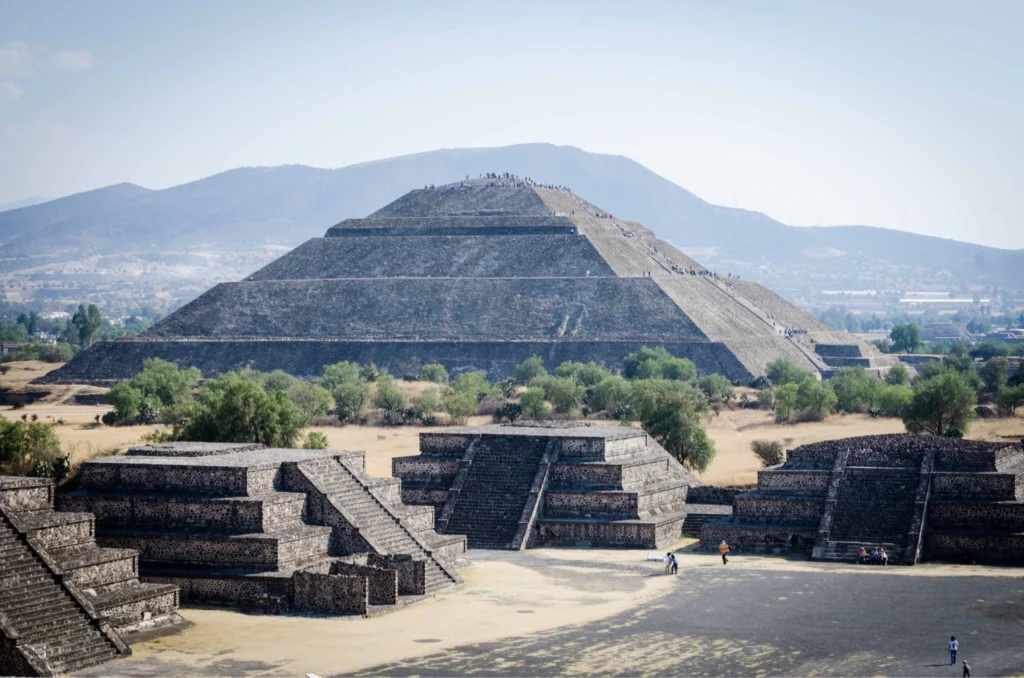
Discovering the Mysteries of Teotihuacan’s Pyramids
Nestled in the heart of Mexico, the ancient city of Teotihuacan stands as a testament to the grandeur and mystery of pre-Columbian civilizations. Known as the “City of the Gods,” this UNESCO World Heritage Site is home to some of the most iconic pyramids in the Americas, including the Pyramid of the Sun and the Pyramid of the Moon. A visit to Teotihuacan offers a journey through history, culture, and architectural ingenuity that will leave any traveler in awe.
The History of Teotihuacan
Teotihuacan’s origins date back to around 100 BCE, and it is believed to have been a thriving metropolis by 450 CE, with a population of over 100,000 people. The city’s founders remain a mystery, as do many aspects of their culture. It predates the Aztecs, who later revered it as a sacred site. Teotihuacan was a hub for trade, religion, and culture, influencing regions far beyond the Valley of Mexico.
The city’s layout reflects a deep understanding of astronomy and urban planning. The main avenue, known as the Avenue of the Dead, aligns with celestial patterns and connects the city’s major structures. The pyramids, temples, and residential complexes are constructed with precision, showcasing the advanced engineering skills of the civilization that built them.
Exploring the Pyramids
The Pyramid of the Sun
Standing at 65 meters tall, the Pyramid of the Sun is the largest structure in Teotihuacan and one of the most massive pyramids in the world. Climbing its 248 steps is a rewarding experience, offering panoramic views of the surrounding area and a closer connection to the ancient city’s spirit. Scholars believe the pyramid was dedicated to solar deities, and its alignment with the sun’s movements suggests it played a vital role in rituals and ceremonies.
The Pyramid of the Moon
At the northern end of the Avenue of the Dead, the Pyramid of the Moon rises majestically. Slightly smaller than the Pyramid of the Sun, it is no less impressive. This pyramid served as a ceremonial center and was closely linked to the Great Goddess, a deity associated with fertility, water, and the earth. Visitors can climb partway up the pyramid for stunning views of the surrounding plaza and the Avenue of the Dead.
The Temple of the Feathered Serpent
Also known as the Temple of Quetzalcoatl, this structure is adorned with intricate carvings of feathered serpents and other symbolic figures. Archaeologists have uncovered evidence of human sacrifices at this site, hinting at the complex and often enigmatic rituals practiced inTeotihuacan.
Cultural Significance
Teotihuacan’s influence extended far and wide. Its art, architecture, and religious practices shaped the development of later Mesoamerican civilizations, including the Maya and the Aztecs. The city’s murals, many of which remain remarkably well-preserved, provide insights into the spiritual beliefs and daily life of its inhabitants. These colorful frescoes depict deities, animals, and abstract designs, offering a glimpse into a world rich in symbolism and meaning.
Planning Your Visit
Getting There
Teotihuacan is located about 50 kilometers northeast of Mexico City, making it an easy day trip. Visitors can choose from several transportation options, including guided tours, public buses, or private cars. For those flying in from abroad or other parts of Mexico, Skyscanner is an excellent resource for finding affordable flights to Mexico City.
Best Time to Visit
The best time to explore Teotihuacan is during the dry season, from November to April. The weather is mild, and the skies are clear, making it ideal for climbing the pyramids and wandering through the expansive site. Arriving early in the morning helps beat the crowds and the midday heat.
Where to Stay
While many visitors choose to stay in Mexico City and visit Teotihuacan as a day trip, there are accommodations closer to the site for those who prefer a more relaxed experience. Options range from boutique hotels to budget-friendly guesthouses. Platforms like Booking.com make it easy to find and book the perfect place to stay.
Tips for a Memorable Visit
- Wear Comfortable Shoes: The site covers a vast area, and you’ll be doing a lot of walking and climbing. Comfortable footwear is a must.
- Bring Sunscreen and a Hat: The open layout of Teotihuacan means there’s little shade, so protecting yourself from the sun is essential.
- Hire a Guide: To fully appreciate the history and significance of Teotihuacan, consider hiring a local guide. They can provide detailed explanations and answer questions, enriching your experience.
- Pack Water and Snacks: While there are vendors near the site, having your own supplies ensures you stay hydrated and energized.
- Respect the Site: Teotihuacan is a cultural treasure. Avoid climbing restricted areas, and refrain from touching or defacing the structures.
Nearby Attractions
For those with extra time, the surrounding area offers additional points of interest. The town of San Juan Teotihuacan is worth exploring for its local crafts and cuisine. Don’t miss the opportunity to sample traditional dishes like barbacoa, a slow-cooked meat dish, or pulque, an ancient fermented beverage.
Another popular activity is a hot air balloon ride over Teotihuacan. Seeing the pyramids from above at sunrise is an unforgettable experience that provides a new perspective on the site’s grandeur.
Final Thoughts
A visit to Teotihuacan is more than just a trip to ancient ruins; it’s a journey through time and an opportunity to connect with a civilization that continues to captivate the imagination. From its towering pyramids to its intricate murals, Teotihuacan offers a glimpse into the ingenuity and spirituality of its builders.
Whether you’re a history enthusiast, an architecture lover, or a curious traveler, Teotihuacan promises an experience that will leave you inspired and in awe. Start planning your adventure today, and let the City of the Gods reveal its secrets to you.





